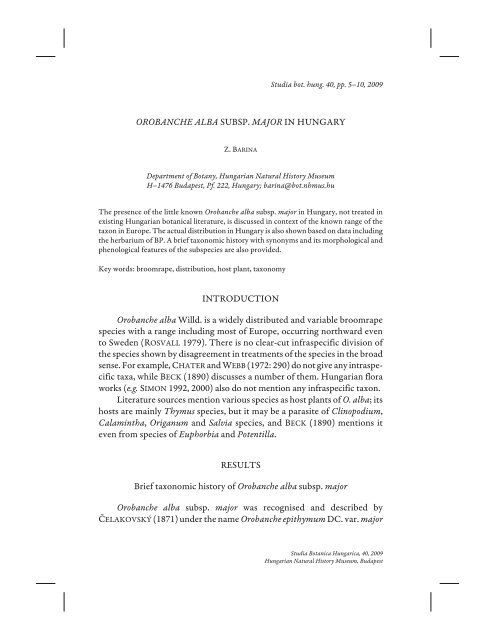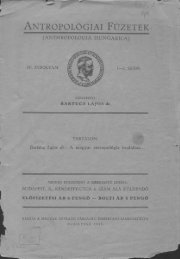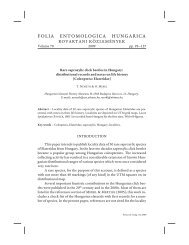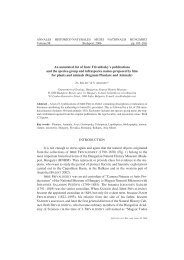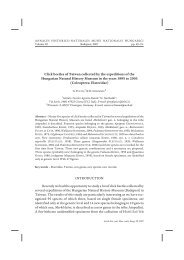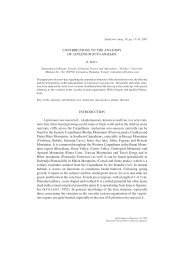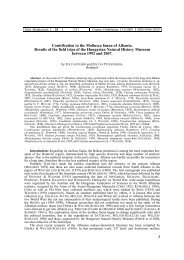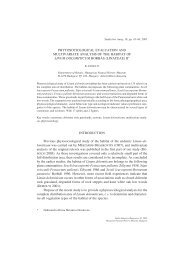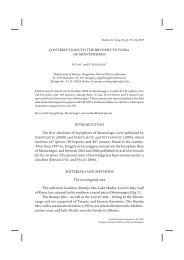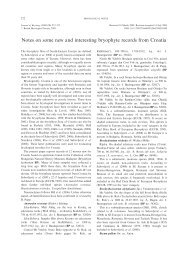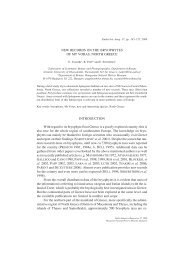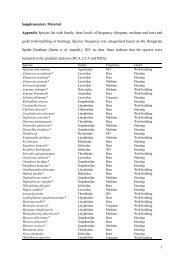OROBANCHE ALBA SUBSP. MAJOR IN HUNGARY ...
OROBANCHE ALBA SUBSP. MAJOR IN HUNGARY ...
OROBANCHE ALBA SUBSP. MAJOR IN HUNGARY ...
- No tags were found...
Create successful ePaper yourself
Turn your PDF publications into a flip-book with our unique Google optimized e-Paper software.
Studia bot. hung. 40, pp. 5–10, 2009<strong>OROBANCHE</strong> <strong>ALBA</strong> <strong>SUBSP</strong>. <strong>MAJOR</strong> <strong>IN</strong> <strong>HUNGARY</strong>Z. BAR<strong>IN</strong>ADepartment of Botany, Hungarian Natural History MuseumH–1476 Budapest, Pf. 222, Hungary; barina@bot.nhmus.huThe presence of the little known Orobanche alba subsp. major in Hungary, not treated inexisting Hungarian botanical literature, is discussed in context of the known range of thetaxon in Europe. The actual distribution in Hungary is also shown based on data includingthe herbarium of BP. A brief taxonomic history with synonyms and its morphological andphenological features of the subspecies are also provided.Key words: broomrape, distribution, host plant, taxonomy<strong>IN</strong>TRODUCTIONOrobanche alba Willd. is a widely distributed and variable broomrapespecies with a range including most of Europe, occurring northward evento Sweden (ROSVALL 1979). There is no clear-cut infraspecific division ofthe species shown by disagreement in treatments of the species in the broadsense. For example, CHATER and WEBB (1972: 290) do not give any intraspecifictaxa, while BECK (1890) discusses a number of them. Hungarian floraworks (e.g. SIMON 1992, 2000) also do not mention any infraspecific taxon.Literature sources mention various species as host plants of O. alba; itshosts are mainly Thymus species, but it may be a parasite of Clinopodium,Calamintha, Origanum and Salvia species, and BECK (1890) mentions iteven from species of Euphorbia and Potentilla.RESULTSBrief taxonomic history of Orobanche alba subsp. majorOrobanche alba subsp. major was recognised and described byÈELAKOVSKÝ (1871) under the name Orobanche epithymum DC. var. majorStudia Botanica Hungarica, 40, 2009Hungarian Natural History Museum, Budapest
6 BAR<strong>IN</strong>A, Z.Èelak. Later BECK (1890), together with many other varieties of O. alba,also listed “(Orobanche) maxima”, and O. epithymum DC. var. major as itssynonym. The description of Beck is not very detailed, and it does not referto any localities or collected specimens. Zázvorka (in KIRSCHNER andZÁZVORKA 2000) elevated Èelakovský’s variety to subspecific level, withthe name Orobanche alba Willd. subsp. major (Èelak.) Zázv.SOÓ (1968) treated the plant under O. a. var. epithymoides (Duby) Rouyas f. maxima (Èelak.) Rouy: “flowers 25–30 mm long, inflorescence denseand many flowered, cylindrical”, and does not mention any other differencesagainst O. alba subsp. alba.SÃVULESCU (1961: 50) discussed the plant as O. alba f. maxima Beck,and highlights the fact, that it is a parasite of Salvia spp.Distribution of Orobanche alba subsp. majorThe locus classicus of O. alba subsp. major is in the Czech Republic,from where Zázvorka published additional occurrences from the area ofÈeské støedohoøí and Bílé Karpaty; also highlighted that Orobanche albahad occurrences in Slovakia in locations where Salvia species were presentand gave a few localities for subsp. major from there (e.g. near Párkány/Šturovo) (ZÁZVORKA 1997).SÃVULESCU (1961: 50) mentions the taxon from Transsylvania citingonly one occurrence: Földra [Feldru] between Óradna and Naszód (Fig. 1).JOSIFOVIÆ (1974: 296) and FISCHER et al. (2005) do not mention any occurrencesof O. alba subsp. major either in Serbia or in Austria.From Hungary SOÓ (1968) mentions it from the Buda and GerecseMts, but does not provide any exact location. In the herbarium of the HungarianNatural History Museum (BP) a few specimens of Orobanche albasubsp. major (rev. Z. Barina) were located, with their original identificationonly giving as Orobanche alba Willd., collected in the surroundings ofHármashatár-hegy (Buda Mts). Supposedly, these have given the basis oftheir records in the Buda Mts in SOÓ (1968); the source of the record of theGerecse Mts is unknown (BAR<strong>IN</strong>A 2006). Specimens of Orobanche fromearly collectors include those of Julius Tauscher near Ercsi (labelled asOrobanche rubens), and from Boros near Lovasberény; all these belong alsoto O. alba subsp. major (rev. Z. Barina) (Appendix 1).Studia bot. hung. 40, 2009
<strong>OROBANCHE</strong> <strong>ALBA</strong> <strong>SUBSP</strong>. <strong>MAJOR</strong> <strong>IN</strong> <strong>HUNGARY</strong> 7In 2001 vigorous populations of this subspecies have been found by theauthor in several locations of the eastern part of the Gerecse Mts (Bajna,Epöl, Gyermely) and at the foot of the Pilis Mts (Kesztölc). In the followingyears many additional occurrences became known in this region (Appendix 2,Fig. 2).Known occurrences of O. alba subsp. major in EuropeActually known distribution of Orobanche alba subsp. major in HungaryStudia bot. hung. 40, 2009
8 BAR<strong>IN</strong>A, Z.Characteristics of Orobanche alba subsp. majorWhile Orobanche alba subsp. alba is a small plant, usually 8–25 cm tall,subsp. major is more robust: 30–65 cm tall. Flowers of subsp. alba are smaller,while those of subsp. major larger (cf. SOÓ 1968). In Hungary subsp.alba flowers from the beginning of May to the beginning or middle June,with main flowering time in middle May; subsp. major usually flowers fromthe beginning of June (some specimens in some years already at the end ofMay), with a mean flowering time in the middle and end of June, but theflowering time may last until middle August.Main host plants of Orobanche alba subsp. alba in Hungary are thymespecies, but based on our observation it exclusively occurs on the species ofThymus, so other hosts in Hungary need to be verified. Orobanche albasubsp. major grows on Salvia species; according to our observations mainlyon S. nemorosa, rarely on S. pratensis, but ZÁZVORKA (1997) mentions italso on S. verticillata.HabitatIn Hungary Orobanche alba subsp. alba occurs in dry – frequentlyrocky – grasslands, while subsp. major in less dry, sometimes semi-dry–humidplaces, e.g. in loess valley bottoms (e.g. Gyermely, Kesztölc, Máriahalom),in forest clearings on Sarmatian limestone (Csabdi), but sometimesalso in arid loess hillsides (Garamkövesd, Sárisáp).DISCUSSIONIt is concluded that besides the relatively common Orobanche albasubsp. alba, another – lesser known – taxon is present in Hungary, namelyOrobanche alba subsp. major. The two subspecies are distinctive in manymorphological characters, they have different host plants, different floweringseasons and they grow in different habitats.* * *Studia bot. hung. 40, 2009
<strong>OROBANCHE</strong> <strong>ALBA</strong> <strong>SUBSP</strong>. <strong>MAJOR</strong> <strong>IN</strong> <strong>HUNGARY</strong> 9Acknowledgements – The author wishes to thank E. Illyés, J. Kochjarová, G. Királyand P. Šmarda for their help in obtaining needed references.REFERENCESBAR<strong>IN</strong>A, Z. (2006): A Gerecse hegység flórája. (Flora of the Gerecse Mountains). – Duna–Ipoly Nemzeti Park, Magyar Természettudományi Múzeum, Budapest, 612 pp.BECK, G. B. (1890): Monographie der Gattung Orobanche. – Verlag von Theodor Fischer,Cassel, 275 pp.CHATER, A. O. and WEBB, D. A. (1972): Orobanche L. – In: TUT<strong>IN</strong>, T. G., HEYWOOD, V.H., BURGES, N. A., MOORE, D. M., VALENT<strong>IN</strong>E, D. H., WALTERS, S. M. and WEBB,D.A. (eds): Flora Europaea 3. Cambridge University Press, Cambridge, pp. 286–294.ÈELAKOVSKÝ, L. J. (1871): Prodromus der Flora von Böhmen. 2. – Fr. Øivnáè, Praha, 955 pp.FISCHER, M. A., ADLER, W. and OSWALD, L. (2005): Exkursionsflora für Österreich, Liechtensteinund Südtirol. 2. Aufl. – Oberösterreichisches Landesmuseum, Linz, 1380 pp.JOSIFOVIÆ, M. (1974): Flore de la Republique Socialiste de Serbie. – Serb. Acad. Sci. Arts,Beograd, 599 pp.KIRSCHNER, J. and ZÁZVORKA, J. (2000): New names of taxa included in the 6th volume of“Flora of the Czech Republic”. – Preslia : 87–89.ROSVALL, T. (1979): Orobanche alba, timjansnyltrot, på Gotland. (Orobanche alba inGotland, Sweden). – Svensk Bot. Tidskr. (1): 1–6.SÃVULESCU, T. (1961): Flora Republicii populare Romîne. – Ed. Acad. Rep. PopulareRomîne, Bucureºti, 707 pp.SIMON, T. (1992): A magyarországi edényes flóra határozója. [The identification book ofthe vascular plants of Hungary]. – Tankönyvkiadó, Budapest, 892 pp.SIMON, T. (2000): A magyarországi edényes flóra határozója. [The identification book ofthe vascular plants of Hungary]. 4th ed. – Nemzeti Tankönyvkiadó Rt., Budapest,976 pp.SOÓ, R. (1968): A magyar flóra és vegetáció rendszertani-növényföldrajzi kézikönyve. 3.(Synopsis systematico-geobotanica florae vegetationisque Hungariae. 3). – AkadémiaiKiadó, Budapest, 506 pp.ZÁZVORKA, J. (1997): Orobanchaceae Vent. – In: GOLIAŠOVÁ, K. (ed.): Flóra SlovenskaV/2. VEDA, vydavate¾stvo Slovenskej akadémie vied, Bratislava, 633 pp.(Received 19 November, 2008)Studia bot. hung. 40, 2009
10 BAR<strong>IN</strong>A, Z.Specimens of Orobanche alba Willd subsp. major(Èelakovský) Zázvorka in BP (rev. Z. Barina)1. Hármashatár-hegy, leg.: Vajda, L. 14.07.1932. BP 2855122. Hármashatár-hegy, leg.: Papp, J. 06.07.1944. BP 4714323. Comit. Fejér. In locis ad marginem silvae vallis Mária-völgy prope Lovasberény, leg.:Boros, Á. 06.06.1937. BP 4589164. Comit. Alb. E radice Thymi … prope oppidum Ercsi (O. rubens), leg.: Tauscher, Gy.06.18685. Comit. Alb. … Peucedanii prope Ercsi Komlós Kert, leg.: Tauscher, Gy. 06.18706. Budapest, Vihar-hegy. Gazdanövény: Stachys. Párta rózaszínbe játszó fehér, sötétebbpontozással [Host plant: Stachys. Corolla pinkish white with darker points],leg.: Vajda, E. 26.06.1949. BP 234588Observed occurrences of Orobanche alba Willdsubsp. major (Èelakovský) Zázvorka in HungaryBajna: Öreg-Õr-hegy (13.06.2001; on Salvia pratensis)Csabdi (Vasztély): Bükkös-tetõ (08.07.2004; on Salvia pratensis)Epöl: Hegyen-át (30.06.2001; on Salvia nemorosa)Gyermely: “Siklóernyõ-hegy” (12.07.2001; on Salvia nemorosa)Kesztölc: Tatárszállás (08.07.2001; on Salvia pratensis)Máriahalom: Ördög-völgy (16.06.2002; on Salvia nemorosa)Sárisáp: Falu fölött (04.07.2003)Úny: Haraszti-dûlõ (16.06.2002; on Salvia nemorosa)Studia bot. hung. 40, 2009


